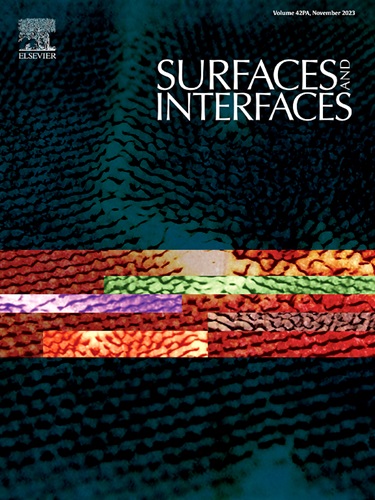The ability of CaFe2O4 manufactured through a straightforward nitrate method for effective H2 generation
IF 5.7
2区 材料科学
Q2 CHEMISTRY, PHYSICAL
引用次数: 0
Abstract
Researchers are now working on creating a highly effective solar-powered device that splits water using a catalyst, addressing the energy crisis and generating green hydrogen. Herein, calcium spinel ferrite CaFe2O4 was successfully employed as a photocatalyst for hydrogen production under visible lighting. CaFe2O4 was prepared using the nitrate route method with nitrates as salt precursors, followed by calcination at 850 °C. Thermal analysis (TGA-DT), X-ray diffractometry (XRD), X-ray photoelectron spectroscopy (XPS), UV visible diffuse reflectance, FT-IR spectroscopy, and scanning electron microscopy (SEM/EDX) were used for structural, compositional, morphological, and optical characterization of the prepared material. XRD verified a single phase of CaFe2O4, showing an orthorhombic structure with a mean crystallite size of 31 nm. The direct band gap of 1.85 eV was estimated from diffuse reflectance data. SEM micrographs exhibited heterogeneous grains with irregular shapes and medium porosity. EDX elemental analysis revealed the occurrence of Ca, Fe, and O, indicating the high purity of the prepared material, while XPS analysis supported these results. The photocatalytic ability of the resultant sample showed optimal hydrogen generation of approximately 139.04 μmol in a Na2SO4 electrolyte (10−3 M) upon visible exposure, even lacking hole scavengers. Interestingly, the occurrence of SO3²⁻ as hole scavengers increased the hydrogen generation by 1.19 times after 30 min of illumination. Also, the stability of the sample was also evaluated throughout 3 straight uses, demonstrating promising stability with a performance drop of (∼21 %). Considering the simplified manufacturing approach and remarkable effectiveness, this research argues that CaFe2O4 might be a promising photocatalyst for renewable and green energy generation.

通过简单的硝酸法制备CaFe2O4有效产氢的能力
研究人员目前正致力于制造一种高效的太阳能设备,该设备使用催化剂分解水,解决能源危机并产生绿色氢。本文成功地将钙尖晶石铁氧体CaFe2O4作为可见光下制氢的光催化剂。以硝酸盐为盐前驱体,采用硝酸还原法制备CaFe2O4,在850℃下煅烧。利用热分析(TGA-DT)、x射线衍射(XRD)、x射线光电子能谱(XPS)、紫外可见漫反射、红外光谱(FT-IR)和扫描电镜(SEM/EDX)对制备的材料进行了结构、成分、形貌和光学表征。XRD证实了CaFe2O4为单相,呈正交结构,平均晶粒尺寸为31 nm。根据漫反射数据估计了1.85 eV的直接带隙。SEM显微图显示出不规则形状和中等孔隙率的非均质颗粒。EDX元素分析显示Ca, Fe和O的存在,表明制备的材料纯度高,而XPS分析支持这些结果。结果表明,在Na2SO4电解质(10−3 M)中,即使没有空穴清除剂,也能产生约139.04 μmol的氢。有趣的是,在30分钟的光照后,SO3²毒枭的出现使氢气的产生量增加了1.19倍。此外,样品的稳定性也在连续3次使用中进行了评估,显示出有希望的稳定性,性能下降(~ 21%)。考虑到简化的制造方法和显著的有效性,本研究认为CaFe2O4可能是一种有前途的可再生能源和绿色能源生产的光催化剂。
本文章由计算机程序翻译,如有差异,请以英文原文为准。
求助全文
约1分钟内获得全文
求助全文
来源期刊

Surfaces and Interfaces
Chemistry-General Chemistry
CiteScore
8.50
自引率
6.50%
发文量
753
审稿时长
35 days
期刊介绍:
The aim of the journal is to provide a respectful outlet for ''sound science'' papers in all research areas on surfaces and interfaces. We define sound science papers as papers that describe new and well-executed research, but that do not necessarily provide brand new insights or are merely a description of research results.
Surfaces and Interfaces publishes research papers in all fields of surface science which may not always find the right home on first submission to our Elsevier sister journals (Applied Surface, Surface and Coatings Technology, Thin Solid Films)
 求助内容:
求助内容: 应助结果提醒方式:
应助结果提醒方式:


